QAbstractItemModel露
- PyQt5.QtCore.QAbstractItemModel
Inherits from QObject.
Inherited by QAbstractItemModelReplica, QAbstractListModel, QAbstractProxyModel, QAbstractTableModel, QConcatenateTablesProxyModel, QDirModel, QFileSystemModel, QHelpContentModel, QStandardItemModel.
Description露
The QAbstractItemModel class provides the abstract interface for item model classes.
The QAbstractItemModel class defines the standard interface that item models must use to be able to interoperate with other components in the model/view architecture. It is not supposed to be instantiated directly. Instead, you should subclass it to create new models.
The QAbstractItemModel class is one of the Model/View Classes and is part of Qt鈥檚 model/view framework. It can be used as the underlying data model for the item view elements in QML or the item view classes in the Qt Widgets module.
If you need a model to use with an item view such as QML鈥檚 List View element or the C++ widgets QListView or QTableView, you should consider subclassing QAbstractListModel or QAbstractTableModel instead of this class.
The underlying data model is exposed to views and delegates as a hierarchy of tables. If you do not make use of the hierarchy, then the model is a simple table of rows and columns. Each item has a unique index specified by a QModelIndex.

Every item of data that can be accessed via a model has an associated model index. You can obtain this model index using the index() function. Each index may have a sibling() index; child items have a parent() index.
Each item has a number of data elements associated with it and they can be retrieved by specifying a role (see ItemDataRole) to the model鈥檚 data() function. Data for all available roles can be obtained at the same time using the itemData() function.
Data for each role is set using a particular ItemDataRole. Data for individual roles are set individually with setData(), or they can be set for all roles with setItemData().
Items can be queried with flags() (see ItemFlag) to see if they can be selected, dragged, or manipulated in other ways.
If an item has child objects, hasChildren() returns true for the corresponding index.
The model has a rowCount() and a columnCount() for each level of the hierarchy. Rows and columns can be inserted and removed with insertRows(), insertColumns(), removeRows(), and removeColumns().
The model emits signals to indicate changes. For example, dataChanged is emitted whenever items of data made available by the model are changed. Changes to the headers supplied by the model cause headerDataChanged to be emitted. If the structure of the underlying data changes, the model can emit layoutChanged to indicate to any attached views that they should redisplay any items shown, taking the new structure into account.
The items available through the model can be searched for particular data using the match() function.
To sort the model, you can use sort().
Subclassing露
Note: Some general guidelines for subclassing models are available in the Model Subclassing Reference.
When subclassing QAbstractItemModel, at the very least you must implement index(), parent(), rowCount(), columnCount(), and data(). These functions are used in all read-only models, and form the basis of editable models.
You can also reimplement hasChildren() to provide special behavior for models where the implementation of rowCount() is expensive. This makes it possible for models to restrict the amount of data requested by views, and can be used as a way to implement lazy population of model data.
To enable editing in your model, you must also implement setData(), and reimplement flags() to ensure that ItemIsEditable is returned. You can also reimplement headerData() and setHeaderData() to control the way the headers for your model are presented.
The dataChanged and headerDataChanged signals must be emitted explicitly when reimplementing the setData() and setHeaderData() functions, respectively.
Custom models need to create model indexes for other components to use. To do this, call createIndex() with suitable row and column numbers for the item, and an identifier for it, either as a pointer or as an integer value. The combination of these values must be unique for each item. Custom models typically use these unique identifiers in other reimplemented functions to retrieve item data and access information about the item鈥檚 parents and children. See the Simple Tree Model Example for more information about unique identifiers.
It is not necessary to support every role defined in ItemDataRole. Depending on the type of data contained within a model, it may only be useful to implement the data() function to return valid information for some of the more common roles. Most models provide at least a textual representation of item data for the DisplayRole, and well-behaved models should also provide valid information for the ToolTipRole and WhatsThisRole. Supporting these roles enables models to be used with standard Qt views. However, for some models that handle highly-specialized data, it may be appropriate to provide data only for user-defined roles.
Models that provide interfaces to resizable data structures can provide implementations of insertRows(), removeRows(), insertColumns(),and removeColumns(). When implementing these functions, it is important to notify any connected views about changes to the model鈥檚 dimensions both before and after they occur:
An insertRows() implementation must call beginInsertRows() before inserting new rows into the data structure, and endInsertRows() immediately afterwards.
An insertColumns() implementation must call beginInsertColumns() before inserting new columns into the data structure, and endInsertColumns() immediately afterwards.
A removeRows() implementation must call beginRemoveRows() before the rows are removed from the data structure, and endRemoveRows() immediately afterwards.
A removeColumns() implementation must call beginRemoveColumns() before the columns are removed from the data structure, and endRemoveColumns() immediately afterwards.
The private signals that these functions emit give attached components the chance to take action before any data becomes unavailable. The encapsulation of the insert and remove operations with these begin and end functions also enables the model to manage QPersistentModelIndex correctly. If you want selections to be handled properly, you must ensure that you call these functions. If you insert or remove an item with children, you do not need to call these functions for the child items. In other words, the parent item will take care of its child items.
To create models that populate incrementally, you can reimplement fetchMore() and canFetchMore(). If the reimplementation of fetchMore() adds rows to the model, beginInsertRows() and endInsertRows() must be called.
Classes露
Enums露
- CheckIndexOption
TODO
Member
Value
Description
DoNotUseParent TODO
TODO
IndexIsValid TODO
TODO
NoOption TODO
TODO
ParentIsInvalid TODO
TODO
- LayoutChangeHint
This enum describes the way the model changes layout.
Note that and carry the meaning that items are being moved within the same parent, not moved to a different parent in the model, and not filtered out or in.
Member
Value
Description
HorizontalSortHint 2
Columns are being sorted.
NoLayoutChangeHint 0
No hint is available.
VerticalSortHint 1
Rows are being sorted.
Methods露
- __init__(parent: QObject = None)
Constructs an abstract item model with the given parent.
- beginInsertColumns(QModelIndex, int, int)
Begins a column insertion operation.
When reimplementing insertColumns() in a subclass, you must call this function before inserting data into the model鈥檚 underlying data store.
The parent index corresponds to the parent into which the new columns are inserted; first and last are the column numbers of the new columns will have after they have been inserted.
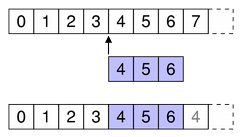
Specify the first and last column numbers for the span of columns you want to insert into an item in a model.
For example, as shown in the diagram, we insert three columns before column 4, so first is 4 and last is 6:
# beginInsertColumns(parent, 4, 6);This inserts the three new columns as columns 4, 5, and 6.
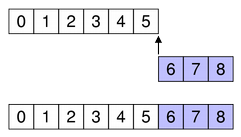
To append columns, insert them after the last column.
For example, as shown in the diagram, we append three columns to a collection of six existing columns (ending in column 5), so first is 6 and last is 8:
# beginInsertColumns(parent, 6, 8);This appends the two new columns as columns 6, 7, and 8.
Note: This function emits the columnsAboutToBeInserted signal which connected views (or proxies) must handle before the data is inserted. Otherwise, the views may end up in an invalid state.
See also
- beginInsertRows(QModelIndex, int, int)
Begins a row insertion operation.
When reimplementing insertRows() in a subclass, you must call this function before inserting data into the model鈥檚 underlying data store.
The parent index corresponds to the parent into which the new rows are inserted; first and last are the row numbers that the new rows will have after they have been inserted.
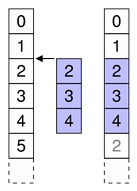
Specify the first and last row numbers for the span of rows you want to insert into an item in a model.
For example, as shown in the diagram, we insert three rows before row 2, so first is 2 and last is 4:
# beginInsertRows(parent, 2, 4);This inserts the three new rows as rows 2, 3, and 4.
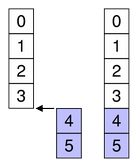
To append rows, insert them after the last row.
For example, as shown in the diagram, we append two rows to a collection of 4 existing rows (ending in row 3), so first is 4 and last is 5:
# beginInsertRows(parent, 4, 5);This appends the two new rows as rows 4 and 5.
Note: This function emits the rowsAboutToBeInserted signal which connected views (or proxies) must handle before the data is inserted. Otherwise, the views may end up in an invalid state.
See also
- beginMoveColumns(QModelIndex, int, int, QModelIndex, int) → bool
Begins a column move operation.
When reimplementing a subclass, this method simplifies moving entities in your model. This method is responsible for moving persistent indexes in the model, which you would otherwise be required to do yourself. Using and endMoveColumns() is an alternative to emitting layoutAboutToBeChanged and layoutChanged directly along with changePersistentIndex().
The sourceParent index corresponds to the parent from which the columns are moved; sourceFirst and sourceLast are the first and last column numbers of the columns to be moved. The destinationParent index corresponds to the parent into which those columns are moved. The destinationChild is the column to which the columns will be moved. That is, the index at column sourceFirst in sourceParent will become column destinationChild in destinationParent, followed by all other columns up to sourceLast.
However, when moving columns down in the same parent (sourceParent and destinationParent are equal), the columns will be placed before the destinationChild index. That is, if you wish to move columns 0 and 1 so they will become columns 1 and 2, destinationChild should be 3. In this case, the new index for the source column
i(which is between sourceFirst and sourceLast) is equal to(destinationChild-sourceLast-1+i).Note that if sourceParent and destinationParent are the same, you must ensure that the destinationChild is not within the range of sourceFirst and sourceLast + 1. You must also ensure that you do not attempt to move a column to one of its own children or ancestors. This method returns
falseif either condition is true, in which case you should abort your move operation.See also
- beginMoveRows(QModelIndex, int, int, QModelIndex, int) → bool
Begins a row move operation.
When reimplementing a subclass, this method simplifies moving entities in your model. This method is responsible for moving persistent indexes in the model, which you would otherwise be required to do yourself. Using and endMoveRows() is an alternative to emitting layoutAboutToBeChanged and layoutChanged directly along with changePersistentIndex().
The sourceParent index corresponds to the parent from which the rows are moved; sourceFirst and sourceLast are the first and last row numbers of the rows to be moved. The destinationParent index corresponds to the parent into which those rows are moved. The destinationChild is the row to which the rows will be moved. That is, the index at row sourceFirst in sourceParent will become row destinationChild in destinationParent, followed by all other rows up to sourceLast.
However, when moving rows down in the same parent (sourceParent and destinationParent are equal), the rows will be placed before the destinationChild index. That is, if you wish to move rows 0 and 1 so they will become rows 1 and 2, destinationChild should be 3. In this case, the new index for the source row
i(which is between sourceFirst and sourceLast) is equal to(destinationChild-sourceLast-1+i).Note that if sourceParent and destinationParent are the same, you must ensure that the destinationChild is not within the range of sourceFirst and sourceLast + 1. You must also ensure that you do not attempt to move a row to one of its own children or ancestors. This method returns
falseif either condition is true, in which case you should abort your move operation.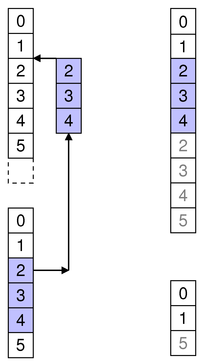
Specify the first and last row numbers for the span of rows in the source parent you want to move in the model. Also specify the row in the destination parent to move the span to.
For example, as shown in the diagram, we move three rows from row 2 to 4 in the source, so sourceFirst is 2 and sourceLast is 4. We move those items to above row 2 in the destination, so destinationChild is 2.
# beginMoveRows(sourceParent, 2, 4, destinationParent, 2);This moves the three rows rows 2, 3, and 4 in the source to become 2, 3 and 4 in the destination. Other affected siblings are displaced accordingly.
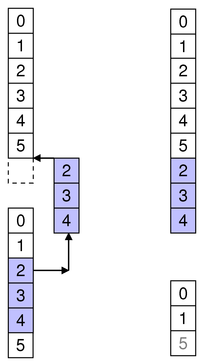
To append rows to another parent, move them to after the last row.
For example, as shown in the diagram, we move three rows to a collection of 6 existing rows (ending in row 5), so destinationChild is 6:
# beginMoveRows(sourceParent, 2, 4, destinationParent, 6);This moves the target rows to the end of the target parent as 6, 7 and 8.
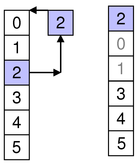
To move rows within the same parent, specify the row to move them to.
For example, as shown in the diagram, we move one item from row 2 to row 0, so sourceFirst and sourceLast are 2 and destinationChild is 0.
# beginMoveRows(parent, 2, 2, parent, 0);Note that other rows may be displaced accordingly. Note also that when moving items within the same parent you should not attempt invalid or no-op moves. In the above example, item 2 is at row 2 before the move, so it can not be moved to row 2 (where it is already) or row 3 (no-op as row 3 means above row 3, where it is already)
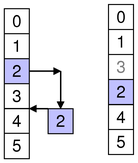
To move rows within the same parent, specify the row to move them to.
For example, as shown in the diagram, we move one item from row 2 to row 4, so sourceFirst and sourceLast are 2 and destinationChild is 4.
# beginMoveRows(parent, 2, 2, parent, 4);Note that other rows may be displaced accordingly.
See also
- beginRemoveColumns(QModelIndex, int, int)
Begins a column removal operation.
When reimplementing removeColumns() in a subclass, you must call this function before removing data from the model鈥檚 underlying data store.
The parent index corresponds to the parent from which the new columns are removed; first and last are the column numbers of the first and last columns to be removed.
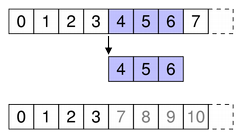
Specify the first and last column numbers for the span of columns you want to remove from an item in a model.
For example, as shown in the diagram, we remove the three columns from column 4 to column 6, so first is 4 and last is 6:
# beginRemoveColumns(parent, 4, 6);Note: This function emits the columnsAboutToBeRemoved signal which connected views (or proxies) must handle before the data is removed. Otherwise, the views may end up in an invalid state.
See also
- beginRemoveRows(QModelIndex, int, int)
Begins a row removal operation.
When reimplementing removeRows() in a subclass, you must call this function before removing data from the model鈥檚 underlying data store.
The parent index corresponds to the parent from which the new rows are removed; first and last are the row numbers of the rows to be removed.
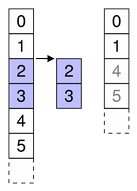
Specify the first and last row numbers for the span of rows you want to remove from an item in a model.
For example, as shown in the diagram, we remove the two rows from row 2 to row 3, so first is 2 and last is 3:
# beginRemoveRows(parent, 2, 3);Note: This function emits the rowsAboutToBeRemoved signal which connected views (or proxies) must handle before the data is removed. Otherwise, the views may end up in an invalid state.
See also
- beginResetModel()
Begins a model reset operation.
A reset operation resets the model to its current state in any attached views.
Note: Any views attached to this model will be reset as well.
When a model is reset it means that any previous data reported from the model is now invalid and has to be queried for again. This also means that the current item and any selected items will become invalid.
When a model radically changes its data it can sometimes be easier to just call this function rather than emit dataChanged to inform other components when the underlying data source, or its structure, has changed.
You must call this function before resetting any internal data structures in your model or proxy model.
This function emits the signal modelAboutToBeReset.
See also
- buddy(QModelIndex) → QModelIndex
Returns a model index for the buddy of the item represented by index. When the user wants to edit an item, the view will call this function to check whether another item in the model should be edited instead. Then, the view will construct a delegate using the model index returned by the buddy item.
The default implementation of this function has each item as its own buddy.
- canDropMimeData(QMimeData, DropAction, int, int, QModelIndex) → bool
Returns
trueif a model can accept a drop of the data. This default implementation only checks if data has at least one format in the list of mimeTypes() and if action is among the model鈥檚 supportedDropActions().Reimplement this function in your custom model, if you want to test whether the data can be dropped at row, column, parent with action. If you don鈥檛 need that test, it is not necessary to reimplement this function.
- canFetchMore(QModelIndex) → bool
Returns
trueif there is more data available for parent; otherwise returnsfalse.The default implementation always returns
false.If returns
true, the fetchMore() function should be called. This is the behavior of QAbstractItemView, for example.See also
- changePersistentIndex(QModelIndex, QModelIndex)
Changes the QPersistentModelIndex that is equal to the given from model index to the given to model index.
If no persistent model index equal to the given from model index was found, nothing is changed.
See also
- changePersistentIndexList(Iterable[QModelIndex], Iterable[QModelIndex])
Changes the {QPersistentModelIndex}es that are equal to the indexes in the given from model index list to the given to model index list.
If no persistent model indexes equal to the indexes in the given from model index list are found, nothing is changed.
See also
- checkIndex(QModelIndex, options: Union[CheckIndexOptions, CheckIndexOption] = NoOption) → bool
TODO
- columnCount(parent: QModelIndex = QModelIndex()) → int
TODO
- createIndex(int, int, object: object = 0) → QModelIndex
TODO
- data(QModelIndex, role: int = Qt.ItemDataRole.DisplayRole) → Any
TODO
- decodeData(int, int, QModelIndex, QDataStream) → bool
TODO
- dropMimeData(QMimeData, DropAction, int, int, QModelIndex) → bool
Handles the data supplied by a drag and drop operation that ended with the given action.
Returns
trueif the data and action were handled by the model; otherwise returnsfalse.The specified row, column and parent indicate the location of an item in the model where the operation ended. It is the responsibility of the model to complete the action at the correct location.
For instance, a drop action on an item in a QTreeView can result in new items either being inserted as children of the item specified by row, column, and parent, or as siblings of the item.
When row and column are -1 it means that the dropped data should be considered as dropped directly on parent. Usually this will mean appending the data as child items of parent. If row and column are greater than or equal zero, it means that the drop occurred just before the specified row and column in the specified parent.
The mimeTypes() member is called to get the list of acceptable MIME types. This default implementation assumes the default implementation of mimeTypes(), which returns a single default MIME type. If you reimplement mimeTypes() in your custom model to return multiple MIME types, you must reimplement this function to make use of them.
- encodeData(Iterable[QModelIndex], QDataStream)
TODO
- endInsertColumns()
Ends a column insertion operation.
When reimplementing insertColumns() in a subclass, you must call this function after inserting data into the model鈥檚 underlying data store.
See also
- endInsertRows()
Ends a row insertion operation.
When reimplementing insertRows() in a subclass, you must call this function after inserting data into the model鈥檚 underlying data store.
See also
- endMoveColumns()
Ends a column move operation.
When implementing a subclass, you must call this function after moving data within the model鈥檚 underlying data store.
See also
- endMoveRows()
Ends a row move operation.
When implementing a subclass, you must call this function after moving data within the model鈥檚 underlying data store.
See also
- endRemoveColumns()
Ends a column removal operation.
When reimplementing removeColumns() in a subclass, you must call this function after removing data from the model鈥檚 underlying data store.
See also
- endRemoveRows()
Ends a row removal operation.
When reimplementing removeRows() in a subclass, you must call this function after removing data from the model鈥檚 underlying data store.
See also
- endResetModel()
Completes a model reset operation.
You must call this function after resetting any internal data structure in your model or proxy model.
This function emits the signal modelReset.
See also
- fetchMore(QModelIndex)
Fetches any available data for the items with the parent specified by the parent index.
Reimplement this if you are populating your model incrementally.
The default implementation does nothing.
See also
- flags(QModelIndex) → ItemFlags
Returns the item flags for the given index.
The base class implementation returns a combination of flags that enables the item (
ItemIsEnabled) and allows it to be selected (ItemIsSelectable).See also
Qt::ItemFlags.
- hasChildren(parent: QModelIndex = QModelIndex()) → bool
Returns
trueif parent has any children; otherwise returnsfalse.Use rowCount() on the parent to find out the number of children.
Note that it is undefined behavior to report that a particular index with this method if the same index has the flag Qt::ItemNeverHasChildren set.
- hasIndex(int, int, parent: QModelIndex = QModelIndex()) → bool
Returns
trueif the model returns a valid QModelIndex for row and column with parent, otherwise returnsfalse.
- headerData(int, Orientation, role: int = Qt.ItemDataRole.DisplayRole) → Any
TODO
- index(int, int, parent: QModelIndex = QModelIndex()) → QModelIndex
TODO
- insertColumn(int, parent: QModelIndex = QModelIndex()) → bool
TODO
- insertColumns(int, int, parent: QModelIndex = QModelIndex()) → bool
On models that support this, inserts count new columns into the model before the given column. The items in each new column will be children of the item represented by the parent model index.
If column is 0, the columns are prepended to any existing columns.
If column is columnCount(), the columns are appended to any existing columns.
If parent has no children, a single row with count columns is inserted.
Returns
trueif the columns were successfully inserted; otherwise returnsfalse.The base class implementation does nothing and returns
false.If you implement your own model, you can reimplement this function if you want to support insertions. Alternatively, you can provide your own API for altering the data.
- insertRow(int, parent: QModelIndex = QModelIndex()) → bool
TODO
- insertRows(int, int, parent: QModelIndex = QModelIndex()) → bool
Note: The base class implementation of this function does nothing and returns
false.On models that support this, inserts count rows into the model before the given row. Items in the new row will be children of the item represented by the parent model index.
If row is 0, the rows are prepended to any existing rows in the parent.
If row is rowCount(), the rows are appended to any existing rows in the parent.
If parent has no children, a single column with count rows is inserted.
Returns
trueif the rows were successfully inserted; otherwise returnsfalse.If you implement your own model, you can reimplement this function if you want to support insertions. Alternatively, you can provide your own API for altering the data. In either case, you will need to call beginInsertRows() and endInsertRows() to notify other components that the model has changed.
See also
insertColumns(), removeRows(), beginInsertRows(), endInsertRows().
- itemData(QModelIndex) → Dict[int, Any]
Returns a map with values for all predefined roles in the model for the item at the given index.
Reimplement this function if you want to extend the default behavior of this function to include custom roles in the map.
See also
- match(QModelIndex, int, Any, hits: int = 1, flags: Union[MatchFlags, MatchFlag] = Qt.MatchStartsWith|Qt.MatchWrap) → List[QModelIndex]
Returns a list of indexes for the items in the column of the start index where data stored under the given role matches the specified value. The way the search is performed is defined by the flags given. The list that is returned may be empty. Note also that the order of results in the list may not correspond to the order in the model, if for example a proxy model is used. The order of the results can not be relied upon.
The search begins from the start index, and continues until the number of matching data items equals hits, the search reaches the last row, or the search reaches start again - depending on whether
MatchWrapis specified in flags. If you want to search for all matching items, use hits = -1.By default, this function will perform a wrapping, string-based comparison on all items, searching for items that begin with the search term specified by value.
Note: The default implementation of this function only searches columns. Reimplement this function to include a different search behavior.
- mimeData(Iterable[QModelIndex]) → QMimeData
Returns an object that contains serialized items of data corresponding to the list of indexes specified. The format used to describe the encoded data is obtained from the mimeTypes() function. This default implementation uses the default MIME type returned by the default implementation of mimeTypes(). If you reimplement mimeTypes() in your custom model to return more MIME types, reimplement this function to make use of them.
If the list of indexes is empty, or there are no supported MIME types, 0 is returned rather than a serialized empty list.
See also
- mimeTypes() → List[str]
Returns the list of allowed MIME types. By default, the built-in models and views use an internal MIME type:
application/x-qabstractitemmodeldatalist.When implementing drag and drop support in a custom model, if you will return data in formats other than the default internal MIME type, reimplement this function to return your list of MIME types.
If you reimplement this function in your custom model, you must also reimplement the member functions that call it: mimeData() and dropMimeData().
See also
- moveColumn(QModelIndex, int, QModelIndex, int) → bool
TODO
- moveColumns(QModelIndex, int, int, QModelIndex, int) → bool
On models that support this, moves count columns starting with the given sourceColumn under parent sourceParent to column destinationChild under parent destinationParent.
Returns
trueif the columns were successfully moved; otherwise returnsfalse.The base class implementation does nothing and returns
false.If you implement your own model, you can reimplement this function if you want to support moving. Alternatively, you can provide your own API for altering the data.
See also
- moveRow(QModelIndex, int, QModelIndex, int) → bool
TODO
- moveRows(QModelIndex, int, int, QModelIndex, int) → bool
On models that support this, moves count rows starting with the given sourceRow under parent sourceParent to row destinationChild under parent destinationParent.
Returns
trueif the rows were successfully moved; otherwise returnsfalse.The base class implementation does nothing and returns
false.If you implement your own model, you can reimplement this function if you want to support moving. Alternatively, you can provide your own API for altering the data.
See also
- parent() → QObject
TODO
- parent(QModelIndex) → QModelIndex
TODO
- persistentIndexList() → List[QModelIndex]
Returns the list of indexes stored as persistent indexes in the model.
- removeColumn(int, parent: QModelIndex = QModelIndex()) → bool
TODO
- removeColumns(int, int, parent: QModelIndex = QModelIndex()) → bool
On models that support this, removes count columns starting with the given column under parent parent from the model.
Returns
trueif the columns were successfully removed; otherwise returnsfalse.The base class implementation does nothing and returns
false.If you implement your own model, you can reimplement this function if you want to support removing. Alternatively, you can provide your own API for altering the data.
- removeRow(int, parent: QModelIndex = QModelIndex()) → bool
TODO
- removeRows(int, int, parent: QModelIndex = QModelIndex()) → bool
On models that support this, removes count rows starting with the given row under parent parent from the model.
Returns
trueif the rows were successfully removed; otherwise returnsfalse.The base class implementation does nothing and returns
false.If you implement your own model, you can reimplement this function if you want to support removing. Alternatively, you can provide your own API for altering the data.
- resetInternalData()
This slot is called just after the internal data of a model is cleared while it is being reset.
This slot is provided the convenience of subclasses of concrete proxy models, such as subclasses of QSortFilterProxyModel which maintain extra data.
# class CustomDataProxy : public QSortFilterProxyModel # { # Q_OBJECT # public: # CustomDataProxy(QObject *parent) # : QSortFilterProxyModel(parent) # { # } # ... # QVariant data(const QModelIndex &index, int role) override # { # if (role != Qt::BackgroundRole) # return QSortFilterProxyModel::data(index, role); # if (m_customData.contains(index.row())) # return m_customData.value(index.row()); # return QSortFilterProxyModel::data(index, role); # } # private slots: # void resetInternalData() # { # m_customData.clear(); # } # private: # QHash<int, QVariant> m_customData; # };
Note: Due to a mistake, this slot is missing in Qt 5.0.
See also
- revert()
Lets the model know that it should discard cached information. This function is typically used for row editing.
See also
- roleNames() → Dict[int, QByteArray]
Returns the model鈥檚 role names.
The default role names set by Qt are:
Qt Role
QML Role Name
display
decoration
edit
toolTip
statusTip
whatsThis
- rowCount(parent: QModelIndex = QModelIndex()) → int
TODO
- setData(QModelIndex, Any, role: int = Qt.ItemDataRole.EditRole) → bool
TODO
- setHeaderData(int, Orientation, Any, role: int = Qt.ItemDataRole.EditRole) → bool
TODO
- setItemData(QModelIndex, Dict[int, Any]) → bool
Sets the role data for the item at index to the associated value in roles, for every ItemDataRole.
Returns
trueif successful; otherwise returnsfalse.Roles that are not in roles will not be modified.
See also
- sibling(int, int, QModelIndex) → QModelIndex
TODO
- sort(int, order: SortOrder = AscendingOrder)
Sorts the model by column in the given order.
The base class implementation does nothing.
- span(QModelIndex) → QSize
Returns the row and column span of the item represented by index.
Note: Currently, span is not used.
- submit() → bool
Lets the model know that it should submit cached information to permanent storage. This function is typically used for row editing.
Returns
trueif there is no error; otherwise returnsfalse.See also
- supportedDragActions() → DropActions
Returns the actions supported by the data in this model.
The default implementation returns supportedDropActions(). Reimplement this function if you wish to support additional actions.
is used by QAbstractItemView::startDrag() as the default values when a drag occurs.
See also
Qt::DropActions, Using drag and drop with item views.
- supportedDropActions() → DropActions
Returns the drop actions supported by this model.
The default implementation returns CopyAction. Reimplement this function if you wish to support additional actions. You must also reimplement the dropMimeData() function to handle the additional operations.
See also
dropMimeData(), Qt::DropActions, Using drag and drop with item views.
Signals露
- columnsAboutToBeInserted(QModelIndex, int, int)
TODO
- columnsAboutToBeMoved(QModelIndex, int, int, QModelIndex, int)
TODO
- columnsAboutToBeRemoved(QModelIndex, int, int)
TODO
- columnsInserted(QModelIndex, int, int)
TODO
- columnsMoved(QModelIndex, int, int, QModelIndex, int)
TODO
- columnsRemoved(QModelIndex, int, int)
TODO
- dataChanged(QModelIndex, QModelIndex, roles: Iterable[int] = [])
TODO
- headerDataChanged(Orientation, int, int)
TODO
- layoutAboutToBeChanged(parents: Iterable[QPersistentModelIndex] = [], hint: LayoutChangeHint = NoLayoutChangeHint)
TODO
- layoutChanged(parents: Iterable[QPersistentModelIndex] = [], hint: LayoutChangeHint = NoLayoutChangeHint)
TODO
- modelAboutToBeReset()
TODO
- modelReset()
TODO
- rowsAboutToBeInserted(QModelIndex, int, int)
TODO
- rowsAboutToBeMoved(QModelIndex, int, int, QModelIndex, int)
TODO
- rowsAboutToBeRemoved(QModelIndex, int, int)
TODO
- rowsInserted(QModelIndex, int, int)
TODO
- rowsMoved(QModelIndex, int, int, QModelIndex, int)
TODO
- rowsRemoved(QModelIndex, int, int)
TODO
